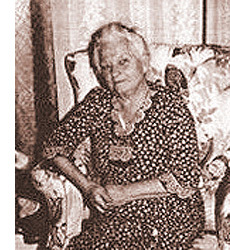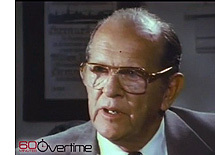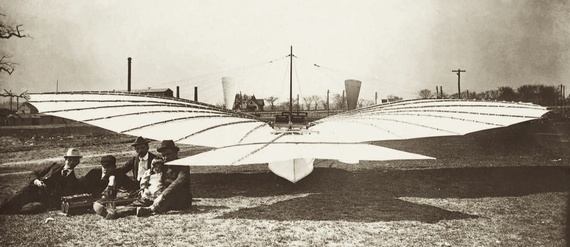In 1974, Gustave Whitehead's supporters were excited to learn there was still a person living who said she had witnessed Whitehead giving a "demonstration" of his flying machine in the early 1900s.
Elizabeth (Papp) Koteles (b. Sep. 20, 1871, in Hungary, d. Oct. 8, 1974, in Bridgeport, Conn.) and her husband, Stephen, witnessed one of Whitehead's "demonstrations" (her word) in 1901 or 1902 or 1903 or later - the date is uncertain.
Mrs. Koteles and her husband lived adjacent to the Gustave Whitehead family in 1901, whose rear yard abutted the Koteles' yard. The Whiteheads were cash customers at the Koteles' grocery store - Mrs. Koteles recalled them being "... nice people. Very nice."
 In her recent book Gustave Whitehead - First in Flight, Susan O'Dwyer-Brinchman devotes nearly two pages in Chapter 6, "Key Testimonies," to her father's 1974 interview of Elizabeth Koteles, who was then in her 90s and by all accounts aware, although hard of hearing.
In her recent book Gustave Whitehead - First in Flight, Susan O'Dwyer-Brinchman devotes nearly two pages in Chapter 6, "Key Testimonies," to her father's 1974 interview of Elizabeth Koteles, who was then in her 90s and by all accounts aware, although hard of hearing.
Among others present at Mrs. Koteles' home in Bridgeport, Connecticut, during the February 2, 1974, interview were USAFR Maj. William J. O'Dwyer, Director of the Gustave Whitehead Research Committee, and father of Susan O'Dwyer-Brinchman; Jesse Davidson, member of the American Aviation Historical Society and the Aviation/Space Writers Association; Harvey P. Lippincott, past president of the Connecticut Aeronautical Historical Association; and Mrs. Koteles' son, son-in-law, and daughter.
Exactly what Mrs. Koteles and her husband witnessed in the early 1900s is unfortunately difficult to discern, since the records of her interviews (one in 1965 and three in 1974) contain several ambiguities and serious contradictions, and are in conflict with the two affidavits she signed on August 1, 1974, two months before her death on October 8th.
POWERED AIRCRAFT or GLIDER ?
On page 212 of her book, Ms. O'Dwyer-Brinchman writes that Harvey Lippincott "noted" Mrs. Koteles...
"... mentioned how the engine sounded, 'It go cajunk, cajunk, cajunk and make hissy noises.' This appeared to describe the engine used in No. 21."
... thus indicating that what Mrs. Koteles saw was a powered machine.
However, Ms. O'Dwyer-Brinchman has made a serious mistake, intentionally or unintentionally and her statement isn't true.
It was Jesse Davidson's notes of this interview, not Harvey Lippincott's, that state Mrs. Koteles said the engine "It go like cajunk, cajunk, cajunk and make hissy noise" (item #12, as designated by Davidson) (Ms. O'Dwyer-Brinchman's quotation differs very slightly from Davidson's typed notes).
So, what did Harvey Lippincott have to say of the Koteles interview ? If he didn't write what Ms. O'Dwyer-Brinchman says he did, what did he write ?
Lippincott's notes, dated February 18, 1974, tell a much different story...
"She further stated that the airplane made no noise, indicating that, probably, the engine employed was not of internal combustion."
So, which is it ?... the engine either made a "cajunk, cajunk, cajunk" "hissy noise" or it made no noise at all.
Lippinoctt tries to cover this over by saying that "... probably, the engine employed was not of internal combustion." - but these are not Mrs. Koteles' words, they're Lippincott's speculation.
Mrs. Koteles said the airplane made no noise.
Was this a simple error on Ms. O'Dwyer-Brinchman's part, saying that Lippincott wrote what Jesse Davidson actually wrote ?
Or, does this "error" indicate something more disturbing, such as an effort to suppress what Harvey Lippincott actually noted in writing 16 days after the interview, that the craft Ms. Koteles saw made no noise - perhaps, therefore, it was not powered - and therefore was likely a glider.
Maj. O'Dwyer comes up with yet another twist on this conflict over what Mrs. Koteles actually told her interviewers. On page 62 of History By Contract, Maj. O'Dwyer writes that she...
"... could recall and imitate the sound of the engine, which indicated it had been a steam one; details she contributed made it probable No. 21 was the airplane she had seen."
Neither Lippincott's notes nor Davidson's notes mention Mrs. Koteles imitating any sound, and just what those details were that she supposedly "contributed" is left unsaid.
Recall that Harvey Lippincott documented that Mrs' Koteles "... further stated that the airplane made no noise..."
DID Mrs. KOTELES TRULY BELIEVE WHITEHEAD FLEW ?
For Whitehead advocates, there's another problem with the interviews of Mrs. Koteles. According to Jesse Davidson's notes, she repeatedly stated "No, he didn't fly" and said the same in one form or another at least six times.
In the two August 1, 1974, affidavits said to be by Mrs. Koteles, the words "fly," "flight" and "flew" are used five times, making it seem as though Mrs. Koteles said Whitehead flew, even though she repeatedly stated he did not fly.
Mrs. Koteles' multiple statements that Whitehead did not fly while she was present are not included in the affidavits, either.
Lippincott remarks of Mrs. Koteles...
"... her general reluctance to discuss the incident, her disinterest of the subject and her statements that his accomplishment was unimportant and insignificant, in my opinion, gives credence to her testimony."
Disconnecting Lippincott's opinion from Mrs. Koteles' expression of "... disinterest of the subject and her statements that his accomplishment was unimportant and insignificant" we're left with Mrs. Koteles telling us that Whitehead did not fly, he hopped, and what she witnessed Whitehead do was "unimportant and insignificant."
So, which is it ?... did Mrs. Koteles see Whitehead "fly" or didn't she ? Mrs. Koteles was clear that she hadn't seen him "fly" - "No. he didn't fly.' 'He only went up a short ways and then came right down. He didn't fly."
Ms. O'Dwyer-Brinchman's book and her father's book, History By Contract, both emphasize that Mrs. Koteles saw Gus Whitehead fly, despite Mrs. Koteles saying the direct opposite, that Whitehead did not fly.
DID SHE or DIDN'T SHE IDENTIFY THE WHITEHEAD No. 21 MACHINE ?
(In Jesse Davidson's August 23, 1974, numbered notes of the February 2, 1974, interview - "you" refers to Maj. O'Dwyer and "her"/"she" refers to Mrs. Koteles)
"#2 ... When you showed her large photographs of Gus Whitehead's No. 21 flying machine, she readily identified Gus Whitehead who was holding his baby daughter Rose in his lap plus three other people sitting in front of the machine."
On page 251 of History By Contract, Maj. O'Dwyer & Randolph, 1978, we find the following...
"Yes, that was the machine." "Mrs. Koteles said as she came upon the photo of Number 21. She had no assistance. It was just one of many photos she selected."
O'Dwyer and Randolph make it sound as though Mrs. Koteles was looking through a stack of photos and spontaneously selected a photo of the Whitehead "No. 21" machine.
However, Harvey Lippincott has a different view of this.
After saying he believed Mrs. Koteles "accurately described what she saw," Harvey Lippincott's February 18th statement tells us "Her remembrance of this flight appears to be somewhat hazy and consequently cannot be relied upon for exactness. The time would appear to be between 1901 and 1903. Nor, can she distinguish between Whitehead airplanes No. 21 and No. 22."
WHAT DID SHE SEE ?
"#4 ... We then posed the question: 'Did you see him fly this airplane in the photo?'" "She studied the photo for some several seconds, looked up at us and said: 'No. he didn't fly.' 'He only went up a short ways and then came right down. He didn't fly.' Mrs. Koteles gestured with her head and hands to dismiss the event as if to say 'it was nothing at all.'"
"#6 ... 'Not that far. I tell you he only went up and come right down.'"
Mrs. Koteles was asked if she saw him go up as high as her 8ft. ceiling and she replied "No, that's too high. Lower." Mrs. Koteles said that Whitehead was "About high as mantelpiece" which was estimated to be 5 to 5-½ feet high.
"#8 ... 'He didn't fly. He just went up and then right down.'"
There was discussion between the interviewers and Mrs. Koteles about how far Whitehead might have gone and by estimation of the distance across the street from her house, those interviewing Mrs. Koteles estimated the distance to be between 150 and 175 feet.
In one of Mrs. Koteles' August 1, 1974, affidavits this estimated distance of "between 150 and 175 feet" becomes "It flew for a distance of approximately 150 to 250 feet before landing." Notice the use of the word "flew" despite Mrs. Koteles' insistence Whitehead had did not fly, and also notice the addition of another 75 feet to the estimate.
Maj. O'Dwyer says (p. 62 History By Contract) that Mrs. Koteles "... provided information about the flight which indicated it had covered a distance of 120 - 200 feet."
As for Harvey Lippincott, he states the following about the length of the "flight" Mrs. Koteles remembered "This distance may have been something on the order of one hundred feet, according to Mrs. Koteles." - fully 150 feet less than the maximum stated in the August 1, 1974, affidavit.
So, which is it ?... 100 feet or 120 feet or 150 feet or 175 feet or 200 feet or 250 feet ?
Maj. O'Dwyer and company chose to use "150 to 250 feet" in the affidavit Mrs. Koteles signed on August 1, 1974... adding to their manipulation and mistreatment of what Mrs. Koteles actually told her interviewers, according to notes taken by those present during the interview.
LANGUAGE CHANGES - Mrs. KOTELES vs. HER AFFIDAVITS
"#4 ... Because of Mrs. Koteles' failing hearing, our questions were repeated and clearly enunciated to her by her daughter. After each question Mrs. Koteles would gaze thoughtfully in space and in her broken english answer them knowledgeably."
Mrs. Koteles was fluent in Hungarian, so it's odd that the interview wasn't conducted in her native language. A subsequent interview was in Hungarian, according to Maj. O'Dwyer, but this interview, the one on February 2, 1974, the one which is best documented and the one which provided the basis for the August 1, 1974, affidavits Mrs. Koteles signed, was in English.
Jesse Davidson notes Mrs. Koteles stated...
"#9 ... 'Whitehead was putting on a demonstration and my husband said let's go see it. He took my hand and we went to watch him fly. But he never flew at all. He only went up a little ways and landed.'"
Contrast that with the August 1, 1974, affidavits signed by Mrs. Koteles...
"One day, not long after Whitehead had built his airplane, and as close as I can recall it was around 1901, my husband asked me to walk with him up to Tunxis Hill, to watch Whitehead fly his airplane."
"#10 ... 'That's all I saw. He might have made others, but that's the only one I went to see.'"
"#14... she merely considered this a 'demonstration' a term she used several times during the interview."
In her book (p. 213), Ms. O'Dwyer-Brinchman tells the reader that "During the interview Mrs. Koteles kept insisting that he didn't fly, 'He just went up and came down.'" and then immediately writes that what Whitehead did was a "flight" - thereby minimizing Mrs. Koteles' insistence that Whitehead did not fly and making it appear as though Mrs. Koteles didn't quite understand what she had seen.
In Ms. O'Dwyer-Brinchman's and Maj. O'Dwyer's and Jesse Davidson's view, Mrs. Koteles had seen Whitehead fly, and they did all they could do to make it appear as though she did see Whitehead fly - despite Mrs. Koteles repeatedly stating he had not flown.
Maj. O'DWYER'S "INTERROGATIONS" - GETTING THE ANSWERS HE WANTED
This manipulation and mangling of the meaning and wording of testimony demands that the interviews conducted by Maj. William O'Dwyer and his committee be subjected to particular scrutiny.
Connecticut State Sen. George Lackman "Doc" Gunther (b. November 22, 1919 - d. August 26, 2012), the longest-serving state legislator in Connecticut history, was intimately familiar with Maj. O'Dwyer, and the Whitehead witness interviews O'Dwyer conducted.
Gunther was deeply involved in trying to reconcile the various factions then doing battle in the 1970s over the Whitehead claims, and made a personal effort to settle the matter. He didn't succeed - in large part because of the publication of Maj. O'Dwyer's and Stella Randolph's 1978 History By Contract which poisoned the atmosphere.
In an interview with this writer, Gunther said he told O'Dwyer that his "interrogations" of people about Whitehead were leading the witness and that O'Dwyer should have asked questions and then simply listened to the answers.
Gunther also said that while he didn't think O'Dwyer "... would make things up..." out of thin air, he knew O'Dwyer "... got the answers he wanted."
---------
So, is it possible to know precisely what Mrs. Koteles said and meant ? That would appear to be a hopeless task, except for one thing... the February 2, 1974, Koteles interview was videotaped.
Ms. O'Dwyer-Brinchman fails to mention that the Koteles interview was videotaped, although she can't be unaware that it was.
She quotes from Jesse Davidson's notes and Davidson clearly states in his notes that the interview was videotaped using equipment and a student crew borrowed from Trumbull High School, and also present, as Davidson notes, was Robert Thompson of Trumbull High School who apparently supervised the student crew.
Ms. O'Dwyer-Brinchman states that the 1965 Koteles interview was audiotaped, so the reason why she would fail to inform her readers that this 1974 interview was videotaped can only be a matter of speculation (speculation such as there are things on the videotape which she would prefer the public not see and hear). Whatever the reason, Ms. O'Dwyer-Brinchman does not explicitly mention this important fact.
It's also a cause for serious concern that Ms. O'Dwyer-Brinchman did not include or mention the supplemental statement by Mrs. Koteles, also dated August 1, 1974, in which Mrs. Koteles mentions that the interview was videotaped.
 The video presumably made its way into the William J. O'Dwyer, Gustave Whitehead Research Collection at the Fairfield Historical Society in Fairfield, Connecticut. To the best of anyone's knowledge the video has not been seen in years. The Koteles videotape is not listed in a finding aid for the O'Dwyer collection.
The video presumably made its way into the William J. O'Dwyer, Gustave Whitehead Research Collection at the Fairfield Historical Society in Fairfield, Connecticut. To the best of anyone's knowledge the video has not been seen in years. The Koteles videotape is not listed in a finding aid for the O'Dwyer collection.
It's interesting to note that Maj. O'Dwyer asked Jesse Davidson and Harvey Lippincott to writeup their notes of what Mrs. Koteles said during the February 2, 1974, interview, considering that the videotape was made, from which a transcript of exactly what she said could have been made.
Interestingly, on page 421 of Ms. O'Dwyer-Brinchman's book, there's the following noted for Elizabeth Koteles on a spreadsheet of witnesses... "Location of Documentation" "CT (taped interviews, transcripts)" - meaning taped interviews and transcripts of the Koteles interviews are held at the Fairfield Historical Society.
If they exist, why are any audiotapes and videotapes - and any transcripts made from them - not readily available to the public, for comparison and study ?
As mentioned previously, the finding aid for the collection at the Fairfield Historical Society does not specify that taped interviews and transcripts of Mrs. Koteles' interviews are held in the collection.
Another interview, on February 13, 1974, included Stella Randolph but it's not known if that interview was videotaped or otherwise recorded.
Maj. O'Dwyer claims that during the interview on the 13th, Mrs. Koteles said "He flew from level ground. It was before 1903. I saw him demonstrate his airplane in 1901. It was on Tunxis Hill at Villa Park." However, that language is not included in either of the two August 1, 1974, affidavits Mrs. Koteles signed. Also missing from the Maj. O'Dwyer/Randolph 1978 book are Mrs. Koteles' repeated statements that Whitehead did not fly while she was present.
---------
Elizabeth Koteles' memories have been held up by Whitehead supporters as important evidence that Gus Whitehead flew some two years prior to Wilbur and Orville Wright.
However, it's plain that the August 1, 1974, affidavits attributed to Mrs. Koteles are not honest and truthful, they do not accurately reflect what she recalled and told her interviewers, and they give a false impression of what she actually said.
Those affidavits were drafted by someone other than Mrs. Koteles and do not quote her directly, although they are written in first person. The affidavits give the impression that Mrs. Koteles was far more certain of things than Harvey Lippincott believed her to be.
The affidavits also give the impression that Mrs. Koteles saw Whitehead fly in a powered machine, which Mrs. Koteles did not say. In fact, as previously stated, Mrs. Koteles repeatedly said Whitehead did not fly, and that the machine made "no noise."
It's time that the full video of Mrs. Koteles' February 2, 1974, interview be located and made public, along with any transcripts which were made of those interviews, so these conflicts and inconsistencies and the apparent broad falsification and manipulation of her testimony can be proven or disproven.
As Connecticut State Sen. George "Doc" Gunther said, Maj. O'Dwyer "... got the answers he wanted."

